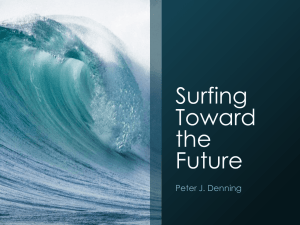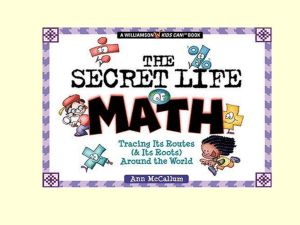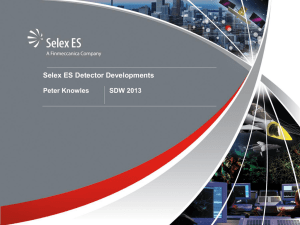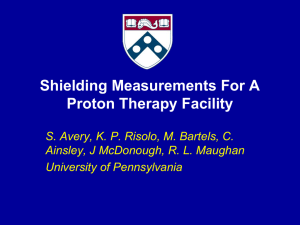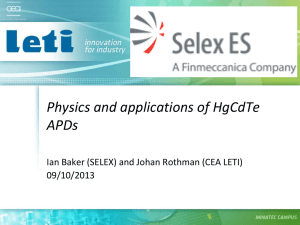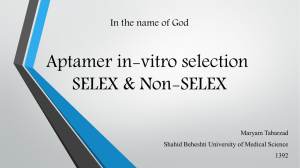Don-Hall
advertisement
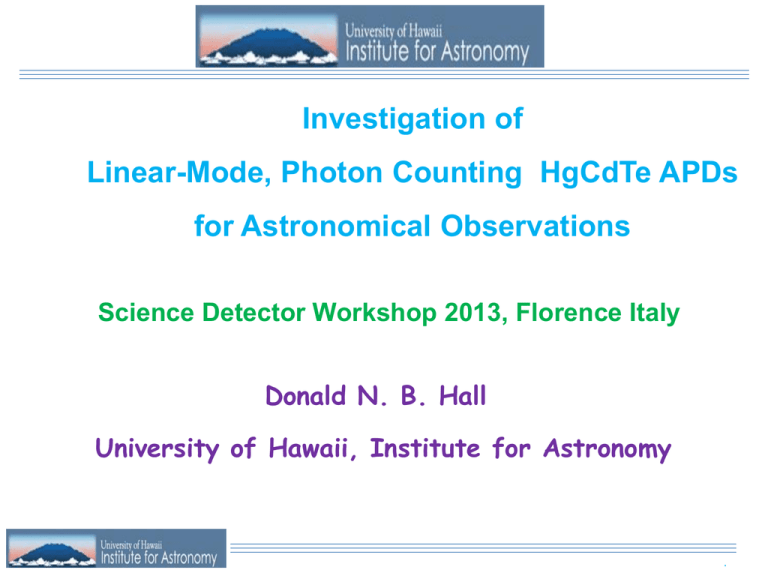
Investigation of Linear-Mode, Photon Counting HgCdTe APDs for Astronomical Observations Science Detector Workshop 2013, Florence Italy Donald N. B. Hall University of Hawaii, Institute for Astronomy . Team • University of Hawaii –Institute for Astronomy: - Dani Atkinson Marta Bryan Klaus Hodapp Shane Jacobson • Raytheon Vision Systems: – – – – – – Mike Jack Justin Wehner Eric Beuville Mark Murray Aaron Ramirez Trish Veeder Overview • Status of University of Hawaii – Raytheon Vision Systems program to develop photon counting HgCdTe L-APD arrays • Noiseless linear-mode avalanche gain can be used either to amplify photo-charge relative to readout noise or, if high enough, to count individual photons • Why count photons when CDS noise is already below 1 rms e- ? • The major challenge is to push back the onset of tunneling current so as to achieve the required avalanche gain at low dark count rate. Advantages of HgCdTe L-APD Approach • “Conventional” APDs exhibit excess noise that severely degrades photon counting in linear mode - Both holes and electrons participate in the avalanche - The avalanche is statistical with redistribution of carriers between ionizing events - Photon counting driven to Geiger mode with its limitations • HgCdTe is unique among known semiconductors in that the linear avalanche process is “noise free” – – – – Only electrons participate in the avalanche process Holes are too “heavy” with low ionization cross section. There are no phonon interactions between ionizing collisions The avalanche is ballistic and so deterministic! • Noiseless avalanche gain can be used either to amplify photocharge relative to readout noise or, if high enough, to count individual photons HgCdTe L-APD Arrays for AO Wavefront Sensing & Fringe Tracking • • • • • Both UH IfA (with NSF ATI funding) and ESO (Gert Finger) have developed L-APD HgCdTe sensors, initially for AO Wavefront Sensing and Fringe Tracking (which are least demanding on dark current at < 100 counts/second): - The UH IfA effort, now partnered with Raytheon Vision Systems, focuses on photon counting - The ESO effort, partnered with Selex, has been directed to avalanche gained charge integration These complimentary efforts build from Defense/Aerospace investment in LADAR and Range Gated Imaging technology: – RVS 4x4 SB415B GHz bandwidth LADAR sensor – Selex Swallow 320x256 LADAR sensor The UH/RVS effort has demonstrated photon counting down into 10 kHz range. The ESO/Selex effort has demonstrated photon noise limited imaging at <100 e/sec gain normalized dark current – Gert’s talk. Both efforts have now developed new readouts optimized for astronomy: – UH-RVS 32X32 HILO from VIRGO – ESO-Selex 320x256 SAPHIRA Under the NSF program Raytheon improved dark current Raytheon demonstrated noiseless photon counting at GHz bandwidth in 2007. NASA ROSES program reduced Dark Count X20 and Surface Current X100,000 in SB415. 2010 Photon Counting with Dark Count ~30,000/sec; Isurf ~10-14A 2007 Photon Counting with Dark Count~500,000/sec; Isurf ~10-9A 6ns pe Slo -0.3 0.20 0.50 urf ~ Is Output (V) Signal (Volts) -0.25 0.25 -0.35 0.15 -0.4 0.10 3ns -0.45 0.05 0 -0.5 120 0 130 10 Slope ~ Isurf 0.60 Doublet Laser Pulse Signal (Volts) -0.2 0.30 140 20 Single Photon events 150 30 Tim e (nS) 160 40 170 50 Time (10-9 sec) Flat Slope Enables Tint to 10ms 0.40 0.30 0.20 0.10 180 60 0.00 0 0.5 1.0 1.5 2.0 Time (10-6 sec) 2.5 Si bandgap images reveal glow from readout amplifiers. Bare readout imaged at Si bandgap wavelength Full Power Reduced Power 100 X exposure L-APD HgCdTe Photon Counting at 10 KHz Frame Rate Outputs #6 and #11 of SB415B - 90 μsec exposures after 10μsec reset with 4 μsec illumination by an IR LED. The vertical scale is 0.5 division per photon UH/RVS photon counting L-APD ROIC approach • • • Base on a proven low background astronomy readout - Raytheon VIRGO glow-suppressed architecture - VIRGO 1k x 1k has demonstrated readout noise - Readout noise scales with Fowler samples averaged - 0.5 μm CMOS process robust against avalanche bias voltages - Paths to further voltage protection 64 output, 32x32 AO tip-tilt wavefront sensor – 64 outputs (32 top and 32 bottom) each reading up to 16 pixels in column – 62.5 KHz frame rate at 1 MHz pixel rate, 250 KHz - 4 MHz – Higher frame rates for rectangular sub-arrays Future: 64 output, 1k x 1k with four 16x16 guide windows – Full frame rate is 60 HZ at 1 MHZ, 240 Hz at 4 MHz – 1k x 1k divided into four quadrants – Each contains a 16x16 guide window UH-RVS HILO development status • 32x32@20 µm pitch SB485 ROIC produced and characterized: - Three versions – basic Virgo unit cell plus two voltage hardened derivatives – HVN and HVP. - All have 64 outputs with perimeter row and column of reference pixels. - Characterized the basic and HVN versions - fully operable and met all requirements. • RVS achieved MBE layers with required micro-defect density. • The program developed both an initial 124 pin LCC test package and a custom package concept. • However detector fabrication resulted in arrays with unacceptably high dark current. • Program is on hold pending outcome of RVS investigation of root cause. • UH has developed laboratory and telescope test capability. KSPEC with Cryogenic Integrating Sphere. . LCC Focal Plane. . Telescope tests will utilize GL Scientific cryostat. . Why Photon Count when Read Noise < 1 rms e- ? • The assumption of uniform signal in each frame, inherent in traditional noise reduction through multiple CDS or SUTR, is not valid at the single photon level: - The ramp is replaced by irregularly timed steps. - Photon events in the first or last frame have zero weight while those half way up the ramp have weight 2. - Solution is to take much longer ramps and to convolve with a template – simplest is a multiple CDS. - Photon counting requires a SNR of ~ 3 or higher. Some examples of photon starved observations • There are both ground based and space observations that require this level of performance: – Ground based IFU spectrographs at the AO diffraction limit, particularly with FBG OH suppression. – IR spectroscopy from Near-Earth/ Sun-Earth L2. – Extra Zodiacal missions enabled by ion drive technology – Extra Zodiacal Explorer – Time domain astronomy • Also allows noiseless binning of photons – Nodding for background, particularly spectroscopic OH suppression. – Sampling throughout a fast period orbit Dark Current in HgCdTe L-APDs • • • Avalanching in HgCdTe requires n-on-p material to inject a photo-electron: - LPE HgCdTe is n-on-p and has been used until now by Selex. - Mature MBE is p-on-n but Raytheon has developed n-on-p for APDs. - Selex is now growing n-on-p with MOVPE in 320x256 format. At low bias voltages the RVS APDs have G-R limited dark current comparable to HAWAII arrays except for differences in maturity of n-on-p technology. As voltage is increased to produce avalanching, there is a precipitous onset of tunneling current: – Band to band tunneling is a fundamental limitation that can be ameliorated by band-gap engineering – Trap assisted tunneling is usually the dominant current. – It can be reduced with lower trap densities/bandgap engineering. • For low background, photon counting applications, the challenge is to achieve the required avalanche gain before the onset of tunneling current! Avalanche Gain vs Tunneling Current for λc ~ 2.5 µm. . The avalanche gain of HgCdTe varies with bandgap. . Towards HgCdTe L-APDs for low background • MBE and MOVPE processes allow for bandgap engineering with: - SEPARATE ABSORPTION AND MULTIPLICATION LAYER BANDGAPS - WIDEST POSSIBLE ABSORPTION LAYER BANDGAP TO IMPROVE SUFACE PASSIVATION - NARROWER MULTIPLICATION LAYER BANDGAP RAISES AVALANCHE GAIN (AT COST OF LOWER OPERATING TEMPERATURE) - BUT INTERMEDIATE ENERGY PHOTONS PASS THROUGH THE ABSORPTION LAYER AND ARE ABSORBED IN MULTIPLICATION LAYER (THERMAL BACKGROUND) • For NASA,explore the optimization of these to achieve highest avalanche gain with low G-R current before the onset of tunneling current: – MEASURE DARK COUNT RATE vs AVALANCHE BIAS VOLTAGE FOR REPRESENTATIVE CRYOGENIC OPERATING TEMPERATURES (35K TO 80K) FOR EXISITING ARRAYS – FEED INTO MODELS AND ITERATE SAM ARCHITECTURE Selex MOVPE enables engineering of bandgap. . UH program • • • IN THE COMING YEAR UH WILL : - CHARACTERIZE SEVERAL EXISTING SELEX SAPHIRA MOVPE ARRAYS (ALREADY ORDERED) FOR AO WAVEFRONT SENSING & LOW BACKGROUND APPLICATIONS - FUND AN MOVPE GROWTH RUN OF APDs WITH IMPROVED ARCHITECTURE - CHARACTERIZE THESE IN THE LAB AT LOW BACKGROUND IN SUBSEQUENT YEARS UH MAY: – FUND FURTHER IMPROVEMENT OF SELEX MOVPE APDs – POSSIBLY IN Selex’s LFNIR FORMAT – 1280X1024@15µM – CHARACTERIZE THESE IN THE LAB AT LOW BACKGROUND AND AT THE UH88 TELESCOPE – WORK WITH Selex TO MODEL PERFORMANCE GOAL IS TO DEVELOP LARGE FORMAT PHOTON COUNTING ARRAYS AND DEMONSTRATE PERFORMANCE FOR NASA ASTROPHYSICS IR (AND VIS) MISSONS.

